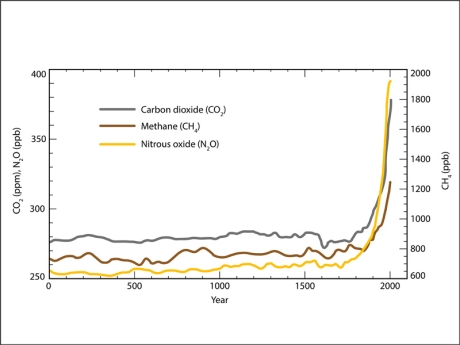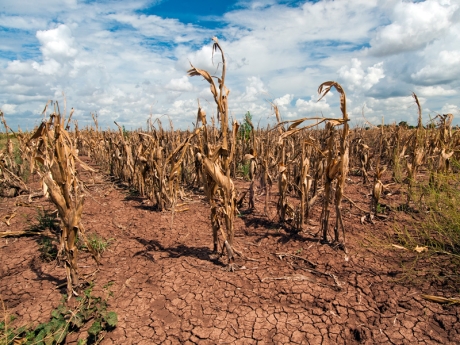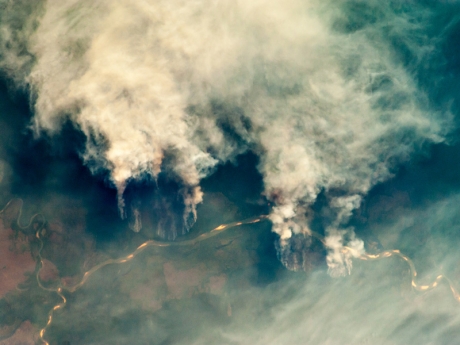Food and Climate Change
Background
The environmental challenge we are undergoing, and its human roots, concern and affect us all.
– Pope Francis

Concentrations of atmospheric greenhouse gases (GHGs).
Prior to the industrial revolution, atmospheric concentrations of GHGs remained relatively stable for thousands of years. Human activities, are considered the dominant cause of the recent and dramatic rise in GHG concentrations.1 Globally, livestock production accounts for an estimate 14.5 percent of GHG emissions related to human activities.6
Image adapted from the IPCC, 2007.3
The term “weather” refers to how the atmosphere behaves in a specific area over a short period of time, usually hours or days. “Climate” refers to general weather patterns over a broad area for a long period of time. Both weather and climate account for qualities like temperature, precipitation, and humidity.
The global climate is warming at an unprecedented rate.1 An overwhelming body of evidence suggests global temperatures will continue to rise, and that human activities such as fossil fuel combustion, deforestation, and agriculture are the dominant cause.1,2 These activities release greenhouse gas (GHG) emissions, such as carbon dioxide, methane, and nitrous oxide, that trap the sun’s heat and warm the atmosphere—hence the name “greenhouse.” Natural processes also produce GHG emissions; however, these have generally been counterbalanced by the capacity of trees, soil, oceans, and other sinks (storehouses) to sequester (capture and store) emissions.3
Climate change is among the greatest threats of our generation—and of generations to come—to public health, ecosystems, and the economy. The projected impacts of climate change, many of which are already occurring, include:
- More frequent and intense hurricanes, floods, heat waves, and other extreme weather events
- Increased heat-related deaths
- Food and water shortages
- Forced migration from rising sea levels and natural disasters
- Increased damages from flooding and wildfires
- Spreading insect-borne and water-borne diseases4
Scientists and world leaders have called for immediate and dramatic action to reduce GHG emissions, enhance emissions sinks,2 and prepare for the impacts that are expected to occur.5 The food system is one of the areas where urgent interventions are needed most.
Impacts of Climate Change on Agriculture

Texas corn crops affected by drought.
For most of the world’s farmers, the effects of climate change—including worsened problems of droughts, flooding, cyclones, heat waves, and pests—are expected to reduce the amount of food they can grow. Impacts to agriculture can in turn lead to higher food prices.7
Photo credit: Bob Nichols, USDA, 2013. Creative Commons CC BY 2.0.
Agriculture has always been at the mercy of unpredictable weather, but a rapidly changing climate is making agriculture an even more vulnerable enterprise. In some regions, warmer temperatures may increase crop yields. The overall impact of climate change on agriculture, however, is expected to be negative—reducing food supplies and raising food prices.7 Many regions already suffering from high rates of hunger and food insecurity, including parts of sub-Saharan Africa and South Asia, are predicted to experience the greatest declines in food production.7–9 Elevated levels of atmospheric carbon dioxide (CO2) are also expected to lower levels of zinc, iron, and other important nutrients in crops.10
With changes in rainfall patterns, farmers face dual threats from flooding and drought. Both extremes can destroy crops. Flooding washes away fertile topsoil that farmers depend on for productivity, while droughts dry it out, making it more easily blown or washed away. Higher temperatures increase crops’ water needs, making them even more vulnerable during dry periods.7
Certain species of weeds, insects, and other pests benefit from higher temperatures and elevated CO2, increasing their potential to damage crops and creating financial hardship for farmers. Shifting climates also mean that agricultural pests can expand to new areas where farmers hadn’t previously dealt with them.11
With higher temperatures, most of the world’s glaciers have begun to recede—affecting farmers who depend on glacial melt water for irrigation.1,5 Rising sea levels, meanwhile, heighten flood dangers for coastal farms, and increase saltwater intrusion into coastal freshwater aquifers—making those water sources too salty for irrigation.12
Climate change is also expected to impact ecosystems and the services they provide to agriculture, such as pollination and pest control by natural predators. Many wild plant species used in domestic plant breeding, meanwhile, are threatened by extinction.13
Food System Contributions to Climate Change

Slash-and-burn rainforest clearing in Matto Grosso, Brazil.
Over 18 percent of the Brazilian Amazon rainforest has been cleared since 1970,16 primarily for cattle ranching.17,18 The Amazon rainforest is one of the world’s most important sinks (storehouses) of carbon, holding the equivalent of 11 years worth of human-caused carbon dioxide emissions.19 Clearing rainforests releases stored carbon, making Brazil among the highest emitters of greenhouse gas emissions in the world.20
Image credit: Image Science & Analysis Laboratory, NASA Johnson Space Center.
Food system activities, including producing food, transporting it, and storing wasted food in landfills, produce greenhouse gas (GHG) emissions that contribute to climate change. Of these sources, livestock production is the largest, accounting for an estimated 14.5 percent of global GHG emissions from human activities.6 Meat from ruminant animals, such as cattle and goats, are particularly emissions-intensive.14
World leaders have agreed that in order to avoid the most catastrophic climate change scenarios, average global temperature rise must not exceed 2° Celsius above pre-industrial levels. Even if this goal is met, many climate impacts, such as sea level rise, will likely still continue for centuries.4
Imagine a scenario in 2050 where societies have transitioned away from coal and natural gas to wind, solar, and other renewable energy sources. In this scenario, public policy and infrastructure investments have made walking, cycling, and public transit the most accessible and popular forms of transportation. Air travel is used only as a last resort. In what is otherwise a best-case scenario, if global trends in meat and dairy intake continue, our chances of staying below the 2° Celsius threshold will still be extremely slim.15 This is why urgent and dramatic reductions in meat and dairy consumption, alongside reductions in GHG emissions from energy use, transportation, and other sources, are crucial to avoiding catastrophic climate change. The responsibility for eating lower on the food chain falls most heavily on countries like the U.S. with the highest per capita consumption of meat and dairy. Changing diets on an international scale will require more than just educating consumers – national policies will need to shift in ways that support more plant-centric diets.15
Resources
The following list of suggested resources is intended as a starting point for further exploration, and is not in any way comprehensive. Some materials may not reflect the views of the Johns Hopkins Center for a Livable Future.
For teachers
- Our Changing Climate (lesson plan). FoodSpan. Johns Hopkins Center for a Livable Future.
- Introduction to the US Food System: Public Health, Environment, and Equity (textbook). Neff RN (editor). Johns Hopkins Center for a Livable Future. 2014.
Reports
- Shifting Diets for a Sustainable Food Future. World Resources Institute. 2016.
- The Importance of Reducing Animal Product Consumption and Wasted Food in Mitigating Catastrophic Climate Change. Johns Hopkins Center for a Livable Future. 2015.
- Tackling Climate Change through Livestock: A global assessment of emissions and mitigation opportunities. Food and Agriculture Organization of the United Nations. 2013.
- Climate Change and Agriculture in the United States: Effects and Adaptation. USDA. 2013.
- Meat Eater's Guide to Climate Change + Health. Environmental Working Group. 2011.
- Climate Change: Impact on Agriculture and Costs of Adaptation. International Food Policy Research Institute. 2009.
Academic journal articles
- Country-specific dietary shifts to mitigate climate and water crises. Brent F. Kim, Raychel E. Santo, Allysan P. Scatterday, Jillian P. Fry, Colleen M. Synk, Shannon R. Cebron, Mesfin M. Mekonnen, Arjen Y. Hoekstra, Saskia de Pee, Martin W. Bloem, Roni A. Neff, Keeve E. Nachman. Global Environmental Change. 2019
- Analysis and valuation of the health and climate change cobenefits of dietary change. Springmanna M, Godfray CJ, et al. PNAS. 2016.
- The importance of reduced meat and dairy consumption for meeting stringent climate change targets (open access). Hedenus F, Wirsenius S, Johansson DJA. Climatic Change. 2014.
- Importance of food-demand management for climate mitigation. Bajželj B, Richards KS, et al. Nature Climate Change. 2014.
- Global diets link environmental sustainability and human health. Tilman D, Clark M. Nature. 2014.
- Increasing CO2 threatens human nutrition. Myers SS, Zanobetti A, Kloog I, et al. Nature. 2014.
- Climate Change Impacts on Global Food Security. Wheeler T and Braun JV. Science. 2013.
- Food-miles and the relative climate impacts of food choices in the United States. Weber CL, Matthews HS. Environmental Science and Technology. 2008.
References
- SUSTAINABILITY For all. The IPCC Report on Climate Change Declares that Human Activity is the Main Cause of Global Warming. 2021. https://www.activesustainability.com/climate-change/ipcc-report-climate-change-2021/?_adin=02021864894
- IPCC. Summary for Policymakers. In: Edenhofer O, Pichs-Madruga R, Sokona Y, et al., eds. Climate Change 2014, Mitigation of Climate Change. Contribution of Working Group III to the Fifth Assessment Report of the Intergovernmental Panel on Climate Change. Cambridge, United Kingdom and New York, NY, USA: Cambridge University Press; 2014.
- IPCC. Climate Change 2007: Working Group I: The Physical Science Basis. Cambridge, United Kingdom and New York, NY, USA: Cambridge University Press; 2007.
- IPCC. Summary for Policymakers. In: Climate Change 2014: Synthesis Report. Contribution of Working Group III to the Fifth Assessment Report of the Intergovernmental Panel on Climate Change. Cambridge, United Kingdom and New York, NY, USA: Cambridge University Press; 2014.
- IPCC. Summary for policymakers. In: Field CB, Barros VR, Dokken DJ, et al., eds. Climate Change 2014: Impacts, Adaptation, and Vulnerability. Part A: Global and Sectoral Aspects. Contribution of Working Group II to the Fifth Assessment Report of the Intergovernmental Panel on Climate Change. Cambridge, United Kingdom and New York, NY, USA: Cambridge University Press; 2014.
- Gerber PJ, Steinfeld H, Henderson B, et al. Tackling Climate Change through Livestock – A Global Assessment of Emissions and Mitigation Opportunities. Rome: Food and Agriculture Organization of the United Nations; 2013.
- Nelson GC, Rosegrant MW, Koo J, Robertson R. Climate Change: Impact on Agriculture and Costs of Adaptation. Washington, D.C.: International Food Policy Research Institute; 2009.
- Gornall J, Betts R, Burke E, et al. Implications of climate change for agricultural productivity in the early twenty-first century. Philos Trans R Soc B Biol Sci. 2010;365(1554):2973-2989.
- Schmidhuber J, Tubiello FN. Global food security under climate change. Proc Natl Acad Sci. 2007;104(50).
- Myers SS, Zanobetti A, Kloog I, et al. Increasing CO2 threatens human nutrition. Nature. 2014;510:139–142.
- U.S. Global Change Research Program. Global Climate Change Impacts in the United States. Cambridge, New York, Melbourne, Madrid, Cape Town, Singapore, São Paulo, Delhi: Cambridge University Press; 2009.
- Backlund P, Janetos A, Schimel D. The Effects of Climate Change on Agriculture, Land Resources, Water Resources, and Biodiversity in the United States. 2008.
- Jarvis A, Upadhyaya H, Gowda C, Aggarwal P, Fujisaka S, Anderson B. Climate Change and Its Effect on Conservation and Use of Plant Genetic Resources for Food and Agriculture and Associated Biodiversity for Food Security. Rome: Food and Agriculture Organization of the United Nations; 2010.
- Tilman D, Clark M. Global diets link environmental sustainability and human health. Nature. 2014;515(7528):518-522.
- Kim B, Neff R, Santo R, Vigorito J. The Importance of Reducing Animal Product Consumption and Wasted Food in Mitigating Catastrophic Climate Change. Johns Hopkins Center for a Livable Future; 2015.
- Butler RA. Calculating Deforestation Figures for the Amazon. Mongabay.com. 2014.
- Greenpeace. Amazon Cattle Footprint: Mato Grosso: State of Destruction. Sao Paulo, Brazil: Greenpeace Brazil; 2009.
- Barona E, Ramankutty N, Hyman G, Coomes OT. The role of pasture and soybean in deforestation of the Brazilian Amazon. Environ Res Lett. 2010;5(2):024002.
- Butler RA. Amazon rainforest locks up 11 years of CO2 emissions. Mongabay.com2. 2007.
- World Resources Institute. CAIT 2.0. 2014.
